On the Singular Spectrum for Adiabatic Quasiperiodic Schrödinger Operators
Abstract
We study spectral properties of a family of quasiperiodic Schrödinger operators on the real line in the adiabatic limit. We assume that the adiabatic iso-energetic curve has a real branch that is extended along the momentum direction. In the energy intervals where this happens, we obtain an asymptotic formula for the Lyapunov exponent and show that the spectrum is purely singular. This result was conjectured and proved in a particular case by Fedotov and Klopp (2005).
1. Introduction
The Iso-Energy Curve Let ℰ(κ) be the dispersion relation associated to H0. Consider the complex and real-isoenergy curves Γℂ and Γℝ defined by
The real iso-energy curve has a well-known role for adiabatic problems [4]. The adiabatic limit can be regarded as a “semiclassical” limit and the Hamiltonian ℰ(κ) + W(ζ) can be interpreted as a “classical” Hamiltonian corresponding to (1.1).
In the case when the interval E − W(ℝ) contains one spectral band (we refer to that by “isolated band” model), the iso-energy curve is presented in Figure 1. The real branches are vertical curves, they are connected by complex loops (closed curves) lying on Γℂ; loops are represented by horizontal closed curves. In this case the connected components are extended in κ-direction and bounded in ζ-direction.
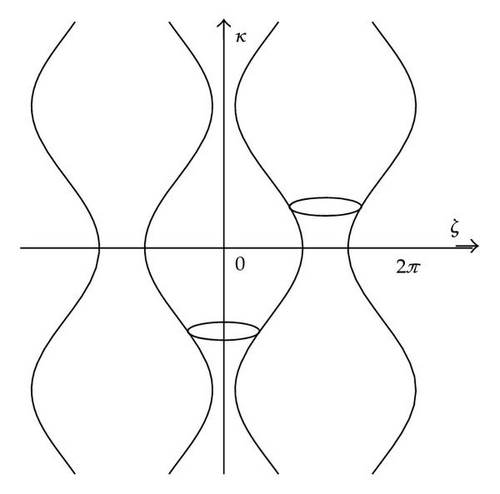
In the case when the interval E − W(ℝ) is contained in a spectral band (we refer to that by the “band middle” model), the iso-energy curve is presented in Figure 2. The horizontal curves are connected components of Γℝ; the vertical loops are situated in Γℂ. In this case the connected components are bounded in κ direction and extended in ζ-direction.
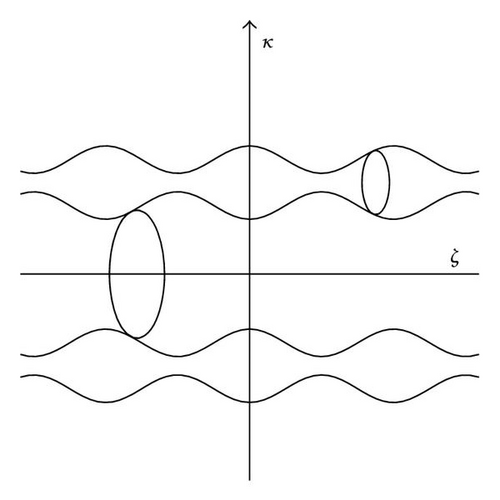
When W has in a period exactly one maximum and one minimum, that are nondegenerate, it is proved in [5] that in the energy intervals where the adiabatic iso-energetic curves are extended along the momentum direction, the spectrum is purely singular. This result leads to the following conjecture: in a given interval, if the iso-energy curve has a real branch (a connected component of the real iso-energy curve Γℝ, see Figure 1 and [5]) that is an unbounded vertical curve, then in the adiabatic limit, in this interval, the spectrum is singular. This paper is devoted to prove this conjecture.
Heuristically when the real iso-energy curve is extended along the momentum axis, the quantum states should be extended in momentum and thus localized in the position space.
1.1. Results and Discussions
Now, we state our assumptions and results.
1.1.1. Assumptions on the Potentials
-
(H1) V and W are periodic:
() -
(H2) V is real-valued and locally square-integrable.
-
(H3) W is real analytic in the strip SY = {z ∈ ℂ; | Im z | < Y}.
1.1.2. Assumptions on the Energy Region
To describe the energy regions where we study the spectral properties, we consider the periodic Schrödinger operator H0 acting on L2(ℝ) and defined by (1.2).
1.1.3. The Periodic Operator
The spectrum of (1.2) is absolutely continuous and consists of intervals of the real axis, say [E2n+1, E2n+2] for n ∈ ℕ, such that E1 < E2 ≤ E3 < E4, …, E2n ≤ E2n+1 < E2n+2, … and En → +∞, n → +∞. The points (Ej) j∈ℕ are the eigenvalues of the self-adjoint operator obtained by considering H0 defined by (1.2) and acting in L2([0,2]) with periodic boundary conditions (see [6, 7]). The intervals [E2n+1, E2n+2], n ∈ ℕ, are the spectral bands, and the intervals (E2n, E2n+1), n ∈ ℕ*, the spectral gaps. When E2n < E2n+1, one says that the nth gap is open; when [E2n−1, E2n] is separated from the rest of the spectrum by open gaps, the nth band is said to be isolated. The spectral bands and gaps are represented in Figure 4.
1.1.4. The Geometric Assumption
-
(H4a) The bands [E2(n+j)−1, E2(n+j)], j = 1,2, …, N, are isolated.
-
(H4b) For all E ∈ J, these bands are contained in the interior of 𝒲(E).
-
(H4c) For all E ∈ J, the rest of the spectrum of H0 is outside of 𝒲(E).
Remark 1.1. The geometric assumption assures that the iso-energy curve Γℝ(E) contains a real branch that is an unbounded vertical curve.
We asked that the window contains only isolated bands of the periodic operator to have a control on the branch points of the Bloch quasimomentum and on its properties of analyticities.
1.1.5. The Main Result
The main object of this paper is to prove the following.
Theorem 1.2. Let J be a real compact interval. We assume that (H1)–(H4) are satisfied. For ε > 0 sufficiently small, for almost all z ∈ ℝ, one has
Remark 1.3. (1) It is proved in [8] that for Σ = σ(H0) + W(ℝ) = σ(H0) + [W−, W+], one has the following for all ε ≥ 0, σ(Hz,ε) ⊂ Σ, and for any K ⊂ Σ, compact, there exists C > 0 such that for all ε sufficiently small and all E ∈ K,
(2) Using the Ishii-Pastur-Kotani Theorem [1, 9], one can see that the result of Theorem 1.2 is deduced from the positivity of the Lyapunov exponent. This will be done by computing the asymptotics for the Lyapunov exponent. With the aim of simplifying the introduction, we do not give it here; it is the subject of Section 3.1.
2. Periodic Schrödinger Operators
This section is devoted to the study of the periodic Schrödinger operator (1.2) where V is a 1-periodic, real-valued, - function. We recall known facts needed on the present paper and we introduce notations. Basic references are [6, 10–12].
2.1. Geometric Description
2.1.1. The Set W−1(ℝ)
As E ∈ ℝ, the set (E − W) −1(ℝ) coincides with W−1(ℝ). It is 2π-periodic. It consists of the real line and of complex branches (curves) which are symmetric with respect to the real line. There are complex branches beginning at the real extrema of W that do not cross again the real line.
- (i)
SY is contained in the domain of analyticity of W;
- (ii)
the set W−1(ℝ)∩SY consists of the real line and of the complex lines passing through the real extrema of W.
An example of subset W−1(ℝ) is shown in Figure 3.
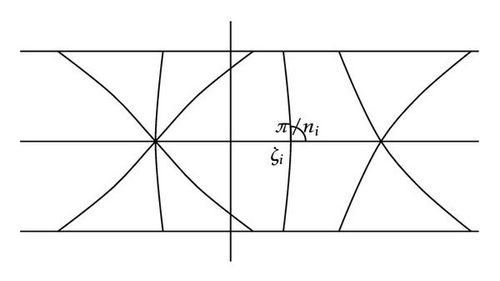
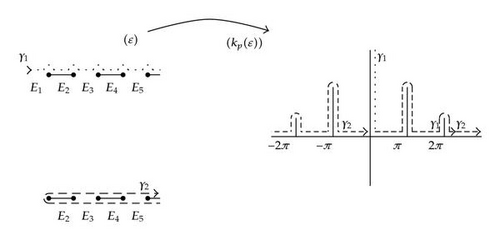
2.1.2. Notations and Description of (E − W) −1(σ(H0))
- (i)
- (ii)
As we deal with the case when the iso-energy curve has a real branch that is extended along the momentum direction, without loss of generality we consider that the connected component is associated to a connected component of Γℝ(E) which is an unbounded vertical curve. See Remark 2.3.
- (iii)
We generally define the following
We have the following description.
Lemma 2.1. Fix [A, B] a compact interval of ℝ.
There exists a finite number p of real extrema of W in [A, B].
-
(i) If p = 0, there exists Y > 0 such that
-
(ii) For p > 0, one denotes by {ζ1, …, ζp} the real extrema of W in [A, B]. There exists Y > 0 and a sequence of disjoint and strictly vertical lines of ℂ+ starting at ζi such that
2.2. Bloch Solutions
As in Section 1.1.2, we denote the spectral bands of the periodic Schrödinger operator by [E2n+1, E2n+2], n ∈ ℕ. Consider 𝒮± two copies of the complex plane ℰ ∈ ℂ cut along the spectral bands. Paste them together to get a Riemann surface with square root branch points. We denote this Riemann surface by 𝒮.
One can construct a Bloch solution ψ(x, ℰ) meromorphic on 𝒮. It is normalized by the condition ψ(1, ℰ) ≡ 1. The poles of this solution are located in the open spectral gaps or at their edges; the closure of each spectral gap contains exactly one pole that, moreover, is simple. It is located either on 𝒮+ or on 𝒮−. The position of the pole is independent of x.
2.3. The Bloch Quasimomentum
Consider the Bloch solution ψ(x, ℰ). The corresponding Floquet multiplier λ(ℰ) is analytic on 𝒮. Represent it in the form λ(ℰ) = exp (ik(ℰ)). The function ℰ ↦ k(ℰ) is the Bloch Quasimomentum of H0. Its inverse k ↦ E(k) is the dispersion relation of H0. A branching point ζ is a point where k′(ζ) = 0.
The function kp conformally maps ℂ+ onto the first quadrant of the complex plane cut at compact vertical slits starting at the points πl, l ∈ ℕ. It is monotonically increasing along the spectral zones so that [E2n−1, E2n], the nth spectral band, is mapped on the interval [π(n − 1), πn]. Along any open gap, Rekp(ℰ + i0) is constant, and Im kp(ℰ + i0) is positive and has only one nondegenerate maximum.
Consider ℂ0, the complex plane cut along the spectral the real line from E1 to +∞. In Figure 4, we drew two curves in ℂ0 and their images under the transformation ℰ ↦ kp(ℰ).
2.4. A Meromorphic Function
Now let us discuss a function playing an important role in the adiabatic constructions.
- (i)
the differential Ω = ωdℰ is meromorphic; its poles are the points of P ∪ Q, where P is the set of poles of ℰ ↦ ψ(x, ℰ), and Q is the set of zeros of k′;
- (ii)
all the poles of Ω are simple;
- (iii)
if the residue of Ω at a point p is denoted by respΩ, one has
() - (iv)
if ℰ ∈ 𝒮 projects into a gap, then ω(ℰ) ∈ ℝ.
- (v)
if ℰ ∈ 𝒮 projects inside a band, then
2.4.1. The Complex Momentum
2.4.2. Index of an Interval
Let us give some properties of pj.
Lemma 2.2. Assume that (H4) is satisfied. The indices pj have the following properties.
- (1)
For j ∈ {1, …, N}, pj ∈ {−1,0, 1}.
- (2)
Proof. The points and are the ends of a band of σ(H0): they are distinct or coincide. If they coincide, that is, if the index pj satisfies pj = 0. Else, we consider kj the branch of the Quasimomentum associated to κj. We have that
Let us prove point (2).As for any j ∈ {1, …, N}, we have |pj| = pjmod 2. We write
This ends the proof of Lemma 2.2.
If pj ≠ 0, we say that we cross a band. In this case, and the associated connected component of the iso-energy curve is unbounded vertically.
We notice that p1 ≠ 0, and thus .
Remark 2.3. We can choose the determination of κ such that p1 = 1.
2.4.3. Tunneling Coefficients
3. The Proof of Theorem 1.2
3.1. The Asymptotics of the Lyapunov Exponent
3.1.1. Spectral Results
One of the main objects of the spectral theory of quasi-periodic operators is the Lyapunov exponent (for a definition and additional information, see, e.g., [9]). The main result of this section is as follows.
Theorem 3.1. We assume that the assumptions (H1)–(H4) are satisfied. Then, on the interval J, for sufficiently small irrational ε/2π, the Lyapunov exponent Θ(E, ε) of (1.1) is positive and satisfies the asymptotics
This theorem implies that if ε/2π is sufficiently small and irrational, then, the Lyapunov exponent is positive for all E ∈ J.
3.2. The Monodromy Matrix and the Lyapunov Exponents
The main object of our study in this subsection is the monodromy matrix for the family of (1.1), and we define it briefly (we refer the reader to [5, 13]). In this paper, we compute the asymptotics of its Fourier expansion in the adiabatic limit.
3.2.1. Definition of the Monodromy Matrix
Definition 3.2. We say that (ψi) i∈{1,2} is a consistent basis of solutions to (3.2) if the two functions ((x, z) ↦ ψi(x, z, E)) i∈{1,2} are a basis of solutions to (3.2) whose Wronskian is independent of z and that are 1-periodic in z, that is, that satisfy
We refer the reader to [5, 10] about the existence and details on consistent basis of solutions to (3.2).
- (i)
- (ii)
M(z, E) is a 2 × 2-matrix with coefficients independent of x.
3.3. The Lyapunov Exponents and the Monodromy Equation
Theorem 3.3 (see [5].)Assume that ε/2π is irrational. The Lyapunov exponents Θ(E, ε) and θ(E, ε) are related by the following relation:
3.4. The Asymptotics of the Monodromy Matrix
The following result gives the asymptotics of A and B in the adiabatic case.
Theorem 3.4. Let E0 be in J. There exists Y > 0 and V0, a neighborhood of E0, such that, for sufficiently small ε, the family of (3.2) has a consistent basis of solutions for which the corresponding monodromy matrix M is analytic in (z, E)∈{z ∈ ℂ; | Im z | < Y/ε} × V0 and has the form (3.12). When ε tends to 0, the coefficients A and B admit the asymptotics
For Y1 and Y2 such that 0 < Y1 < Y2 < Y, there exists V = V(Y1, Y2) a neighborhood of E0 such that the asymptotics (3.13) and (3.14) for A and B are uniform in (z, E)∈{z ∈ ℂ; Y1/ε<|Im z | < Y2/ε} × V.
Remark 3.5. The coefficients A+, A−, B+, and B− are the leading terms of the asymptotics of the Q∓th and P∓th Fourier coefficients of the monodromy matrix coefficients. From Theorem 3.4, one deduces that, in the strip {−Y < Im ζ < Y}, only a few Fourier series terms of the monodromy matrix dominate.
3.5. The Proof of Theorem 3.1
3.5.1. The Upper Bound
3.5.2. The Lower Bound
For (M(z, ε) 0<ε<1) a family of SL(2, ℂ)-valued, 1-periodic functions of z ∈ ℂ, and h an irrational number, we recall the following result obtained in [8].
Proposition 3.6. Fix ε0 > 0. Assume that there exist y0 and y1 such that 0 < y0 < y1 < ∞ and such that, for any ε ∈ (0, ε0), one has
- (i)
the function z → M(z, ε) is analytic in the strip S = {z ∈ ℂ; 0 ≤ Im z ≤ y1/ε};
- (ii)
in the strip S1 = {z ∈ ℂ; y0/ε ≤ Im z ≤ y1/ε} ⊂ S, M(z, ε) admits the representation
()for some constant λ(ε), some integer n0, and a matrix M0(ε), all of them independent of z; - (iii)
- (iv)
there exist constants β > 0 and α ∈ (0,1) independent of ε such that |α(ε)| ≤ α and |β(ε)| ≤ β;
- (v)
as ε → 0.
Proposition 3.6 is used by applying the arguments of [5, 10] to get the lower bound for the Lyapunov exponent.
First for we prove that the matrix σM(z, E)σ completes the assumption of Proposition 3.6.
Let y0 and y1 be fixed such that 0 < y0 < y1 < Y. The asymptotics of the monodromy matrix are uniform for z in S = {z ∈ ℂ; y0/ε ≤ Im z ≤ y1/ε} and E ∈ V0.
Remark 3.7. When n = NN in (5.16) is odd, then we get
3.5.3. Conclusion
Recall that V0∩ℝ is an open interval containing E0 ∈ J. The above construction can be carried out for any E0 ∈ J. The end of the proof of Theorem 1.2 follows from the compactness of the interval J.
4. The Complex WKB Method for Adiabatic Problems
4.1. Standard Behavior of Consistent Solutions
We start by defining another analytic object central to the complex WKB method, the canonical Bloch solutions. Then, we describe the standard behavior of the solutions.
4.1.1. Canonical Bloch Solutions
The properties of the differential Ω imply that the solutions Ψ± can be analytically continued from V0 to any regular domain containing V0.
4.2. Solutions Having Standard Asymptotic Behavior
Fix E = E0. Let D be a regular domain (i.e., D ⊂ D(W), and simply connected set containing no branch points of κ). Fix ζ0 ∈ D so that ℰ(ζ0) ∉ P ∪ Q. Let κ be a continuous branch of the complex momentum in D, and let Ψ± be the canonical Bloch solutions normalized at ζ0 defined on D and indexed so that κ is the Quasimomentum for Ψ+.
Definition 4.1. Let σ ∈ {+, −}. We say that, in D, a consistent solution f has standard behavior (or standard asymptotics) if
- (i)
there exists V0, a complex neighborhood of E0, and X > 0 such that f is defined and satisfies (4.1) and (4.2) for any (x, ζ, E)∈(−X, X) × D × V0;
- (ii)
f is analytic in ζ ∈ D and in E ∈ V0;
- (iii)
for any compact set K ⊂ D, there exists V ⊂ V0, a neighborhood of E0, such that, for (x, ζ, E)∈(−X, X) × K × V, f has the uniform asymptotic:
() - (iv)
this asymptotic can be differentiated once in x without loosing its uniformity properties. We set
()
4.3. Some Results on the Continuation of Asymptotics
4.3.1. Description of the Stokes Lines near
This section is devoted to the description of the Stokes lines under assumption (H4).
4.3.2. Definition
4.3.3. Stokes Lines for E0 ∈ J
We describe the Stokes lines beginning at and . Since W is real on ℝ, the set of the Stokes lines is symmetric with respect to the real line.
First, κ1 is real on the interval ; therefore this set is a Stokes line starting at . The two other Stokes lines beginning at are symmetric with respect to the real axis. We denote by the Stokes line going downward and by its symmetric. Similarly, we denote by and the two other Stokes lines starting at , and goes upward. These Stokes lines are represented in Figure 5.
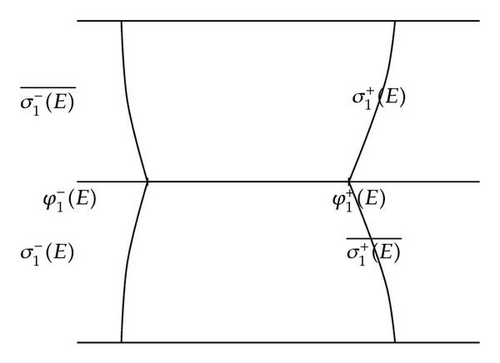
Lemma 4.2. The Stokes lines and satisfy the following properties.
- (i)
The Stokes lines and stay vertical.
- (ii)
and do not intersect one another.
The proof of this lemma is similar to the studies done in [5, 14, 17, 18]. We do not give the details.
4.4. Construction of a Consistent Basis near
We recall this result, proved in [17].
Proposition 4.3 (see [17].)Fix E0 ∈ J, and let κ1 be a continuous determination of the complex momentum on . There exists a real number Y > 0, a complex neighborhood 𝒱1 of E0, and a consistent basis (f1, (f1) *) of solutions of (4.1) such that f1 has the standard asymptotic behavior:
We mimic the analysis done in [5, Section 5]. Precisely, we start by a local construction of the solution f using canonical domain; then, we apply continuation tools, that is, the rectangle lemma, the adjacent domain principle, and the Stokes Lemma.
5. The Proof of Theorem 3.4
The Proof of Theorem 3.4 follows the same ideas as the computations given in [5, Section 10.2]. Below we give the details for the proof of (3.13), (3.14), and (3.15).
5.1. Strategy of the Computation
We now begin with the construction of the consistent basis the monodromy matrix of which we compute. Recall that (H1)–(H4) are satisfied.
In the present section, we construct and study a solution f of (3.2) satisfying (3.3).
Therefore, we will compute the Fourier series of A and B. The strategy of the computation is based on the ideas of [5] and we first recall some notions presented there. We refer the reader to this paper for more details.
As the solutions h and g satisfy the consistency condition (4.2), their Wronskian is ε-periodic in ζ.
5.1.1. Arcs
We assume that Dg∩Dh contains a simply connected domain . Let γ be a regular curve going from ζg to ζh in the following way: staying in Dg, it goes from ζg to some point in , and then, staying in Dh, it goes to ζh. We say that γ is an arc associated to the triple h, g, and .
As is simply connected, all the arcs associated to the triple, h, g, and . As is simply connected, all the arcs associated to one and the same triple can naturally be considered as equivalent; we denote them by .
5.1.2. The Meeting Domain
Let be as above. We call a meeting domain, if, in , the functions Im κh and Im κg do not vanish and are of opposite signs.
Note that, for small values of ε, whether ζ ↦ g(x, ζ) and ζ ↦ h(x, ζ) increase or decrease is determined by the exponential factor and . So, roughly, in a meeting domain, along the lines Im ζ = Const, the solutions h and g increase in opposite directions.
5.1.3. The Action and the Amplitude of an Arc
5.2. Results on the Fourier Coefficients
We recall the following result from [5].
Proposition 5.1. Let d = d(h, g) be a meeting domain for h and g, and let m = m(h, g, d) be the corresponding index. Then
5.2.1. The Index m
Let ζ0 be a regular point. Consider a regular curve γ going from ζ0 to ζ0 + 2π. Let κ be a branch of the complex momentum that is continuous on γ. We call the couple (γ, κ) a period. Let (γ1, κ1) and (γ2, κ2) be two periods. Assume that one can continuously deform γ1 into γ2 without intersecting any branching point. By this we define an analytic continuation of κ1 to γ2. If the analytic continuation coincides with κ2, we say that the periods are equivalent.
Lemma 5.2 (see [10].)Let (γ, κ) be a period such that γ starts at a point ζ0 ∉ 𝒢.Assume that γ intersects 𝒢 exactly n times (n ∈ ℕ) and that at all intersection points, W′ ≠ 0. Let r1, …, rn be the values that Reκ takes consecutively at these intersection points as ζ moves along γ from ζ0 to ζ0 + 2π. Then,
5.3. The Fourier Coefficients
5.3.1. For B
5.3.2. Above the Real Line
We take the meeting domain D0 as the subdomain of the strip 0 < Im ζ < Y between the Stokes lines and In this domain we have Im κg = −Im κh < 0. Indeed we notice that the sign of Im κ changes to opposite one as ζ intersects 𝒵 at a point where W′ ≠ 0 taking into account that κg(ζ) = κh(ζ + 2π), and to go from ζ to ζ + 2π one has to intersect ℬ1.
The arc γ0 connects the point ζg to ζh. By (5.14), this defines the period (γ0, κg). Using (5.15), one gets that m(f(·, ζ), f(·, ζ + 2π, D0)) = m(γ0 + 2π, κ) [5].
We use Lemma 5.2 to compute the index. To do this, we have to compute Reκ at the intersection of γ0 + 2π and 𝒢.
As ζ → Reκ(ζ) is constant on any connected component 𝒢j of 𝒢. Let us start by defining the index of 𝒢j, the result of the alternated character of the coefficients (…, +, −, +, −, …) due to the crossing of 𝒢j (see Lemma 5.2). We notice that .
5.3.3. Below the Real Line
Below the real line, we take the domain of the strip −Y < Im ζ < 0 located between the stokes line and as a regular domain, which we denote by . We set then it defines a period, and so . The curve defining a period equivalent to is represented in Figure 6.

5.4. For A
5.4.1. Above the Real Line
In this case, the meeting domain, is the subdomain of the strip {0 < Im ζ < Y} located between the lines and the symmetric to with respect to ℝ. The arc defines a period in Figure 7 we represent the curve

5.4.2. Below the Real Line
5.4.3. The Proof of (3.15)
Let g ∈ 𝒢. Let V(g) be a complex neighborhood of g sufficiently small so that it contains only two branch points of κ, namely, the ends of g. Let γg be a curve in V(g)∖g; the tunneling action is defined as From [5], we recall the following lemma.
Lemma 5.3 (see [5].)Let E ∈ J. If γg is positively oriented, then
Below we give details only for A+; the same way could be used to obtain the result for A− and B − ±.
Acknowledgments
The authors would like to thank F. Klopp for proposing this problem and many valuable comments and remarks and the referee for his valuable comments which improve the paper. M. Marx thanks M. Ben Ammar the director of the Research Unity 01/UR/15-01 for the financial support by paying her mission in Tunisia. H. Najar thanks R. Assel and M. Dimassi for suggesting some interesting references and for their stimulating discussion. Researches are supported by CMCU 09G1504 and the research Unity 01/UR/15-01 projects.




